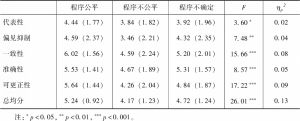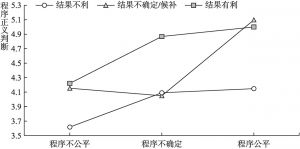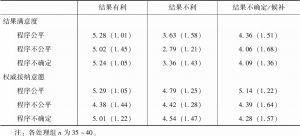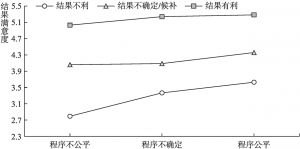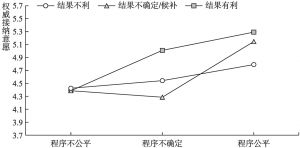论文
程序公平性和结果有利性对儿童程序正义判断、结果满意度与权威接纳意愿的影响
摘要
本研究通过权威决策假设情境实验任务,探讨程序公平性和结果有利性对小学高年级儿童程序正义判断的影响,以及程序正义判断在程序公平性与结果满意度之间、程序公平性与权威接纳意愿之间的中介作用。344名小学五年级儿童(M=10.76岁)被随机分派到3(程序公平性:公平、不公平、不确定)×3(结果有利性:有利、不利、不确定/候补)被试间设计的各处理组,随后完成程序正义判断、结果满意度和权威接纳意愿的测量。结果显示,小学高年级儿童对权威决策的程序公平性敏感,程序公平条件下的程序正义判断显著高于程序不公平和程序不确定条件下的程序正义判断;结果有利性对程序正义判断主效应显著,结果有利条件显著高于结果不利条件,但与结果不确定/候补条件无显著差异;程序公平性和结果有利性的交互作用显著,在程序确定(公平或不公平)条件下,结果不确定/候补时的程序正义判断与结果有利时相似,而在程序不确定条件下,结果不确定/候补时的程序正义判断则与结果不利时相似。程序公平性对结果满意度和权威接纳意愿的主效应均显著,程序正义判断在程序公平性与结果满意度之间、程序公平性与权威接纳意愿之间均起中介作用。
参考文献 查看全部 ↓
检索正文关键字
论文目录
-
一 引言
- (一)程序正义与权威关系模型
- (二)儿童的程序正义概念以及儿童与权威之间的关系
- 1.儿童程序正义概念的研究背景
- 2.儿童程序正义概念的早期发展
- 3.权威决策程序公平性对儿童程序正义判断和权威接纳意愿的影响
- 4.结果有利性和程序公平性对儿童程序正义判断的交互作用
- 5.以往儿童程序正义概念发展研究的不足之处
- (三)研究目的和假设
-
二 方法
- (一)被试
- (二)实验设计和程序
- 1.自变量的操纵
- 2.中介变量的测量
- 3.因变量的测量
- (三)统计分析
-
三 结果
- (一)初步分析和操纵检验
- (二)程序公平性和结果有利性对程序正义判断的影响
- (三)程序公平性和结果有利性对结果满意度和权威接纳意愿的影响
- (四)程序正义判断的中介作用
-
四 讨论
- (一)小学高年级儿童的程序正义判断
- (二)程序公平性对结果满意度和权威接纳意愿的影响
- (三)研究意义、局限和展望
- 五 结论
相关文献
宽容对小学生外化问题行为的影响:友谊质量、敌意归因的中介作用
程序公平性和结果有利性对儿童程序正义判断、结果满意度与权威接纳意愿的影响
查看更多>>>




